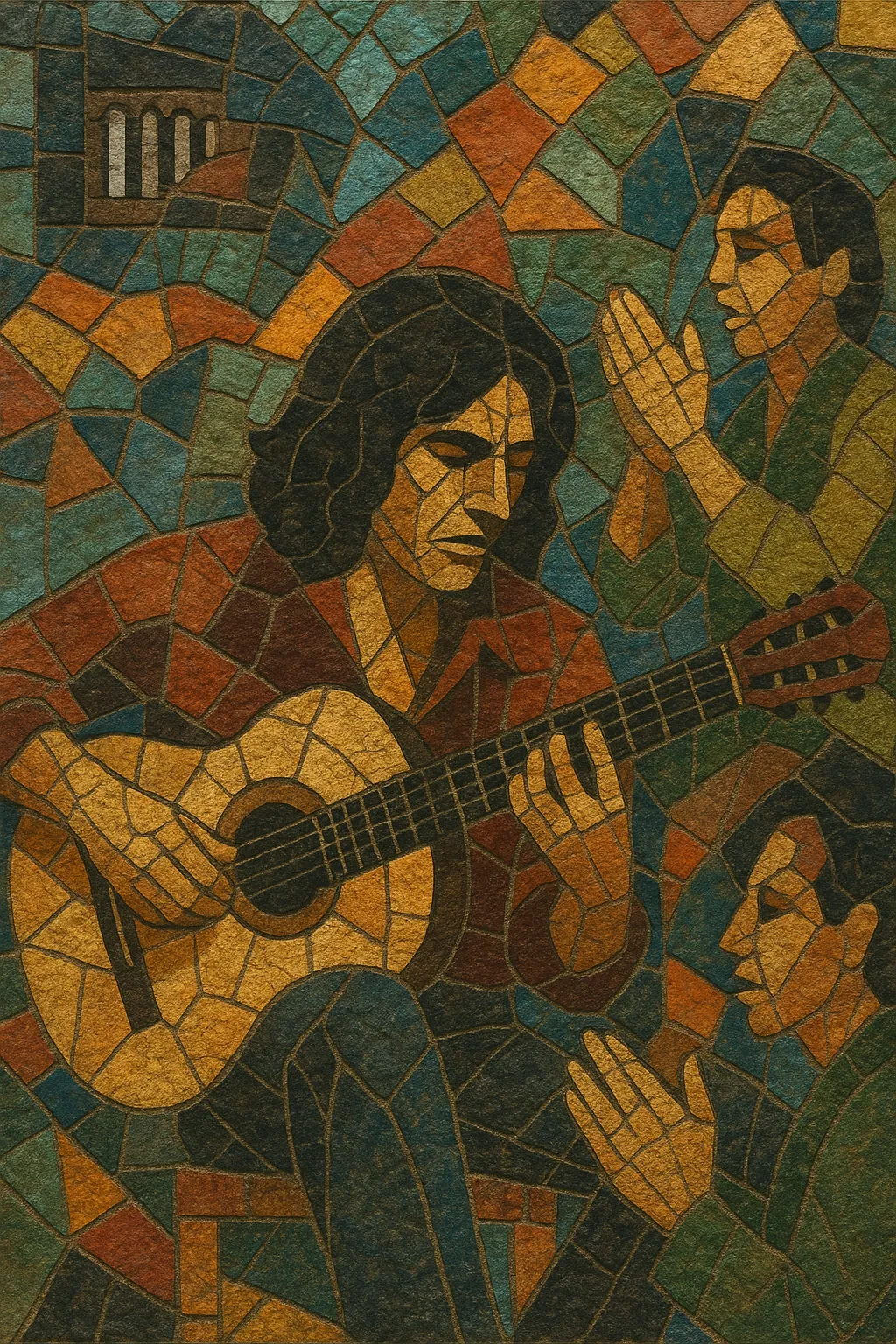Rock andaluz (Andalusian rock) is a Spanish fusion of progressive and psychedelic rock with flamenco and Andalusian folk traditions.
It combines electric guitars, bass, and drums with flamenco guitar, palmas (handclaps), and cante jondo–inspired vocals, often within expansive, symphonic arrangements.
Characteristically, it draws on Phrygian and Phrygian-dominant modes, the Andalusian cadence (i–♭VII–♭VI–V), and flamenco compás patterns (e.g., bulería, tangos, rumba), while embracing the timbres and structures of 1970s prog (Hammond organ, Mellotron, Moog, long instrumental passages).
Lyrically, it reflects Andalusian identity, poetic imagery, and the social winds of Spain’s late-Franco and Transition eras.
Pioneers in Seville and other Andalusian cities began mixing rock instrumentation with flamenco aesthetics. Smash, led by Gualberto García, experimented with psychedelic rock and flamenco guitar, setting a template for the style’s modal and rhythmic blend. The scene coalesced around local venues, producers, and a new generation of musicians eager to modernize Andalusian musical heritage.
Triana’s debut (1975, popularly known as "El Patio") crystallized the genre: cante-influenced vocals, Phrygian harmony, and symphonic prog textures. Bands like Imán Califato Independiente, Alameda, Cai, Guadalquivir, Mezquita, and Goma expanded the palette, weaving jazz-rock, symphonic rock, and flamenco compás into extended forms. This period coincided with Spain’s democratic Transition, when cultural openness and regional identities fueled artistic innovation.
By the turn of the 1980s, Medina Azahara brought a harder, more arena-ready strain that helped sustain the style’s popularity. Regional support—especially in Andalusia—kept the scene vibrant, even as it branched into jazz-fusion, folk-inflected prog, and more radio-friendly formats.
The rise of synth-pop and the Movida madrileña shifted mainstream attention, and many groups disbanded or changed direction. Yet the catalog endured, and periodic revivals—reissues, reunions, tribute projects—have reaffirmed the genre’s legacy. Contemporary fusions in flamenco pop and urbano, as well as Spanish rock acts, often acknowledge rock andaluz as a foundational influence on modern Andalusian musical identity.
Blend a classic rock rhythm section (electric guitar, bass, drums) with flamenco guitar (nylon-string) and hand percussion (palmas; cajón can be used in modern settings). Add Hammond organ, Mellotron, Moog, or Rhodes for symphonic/prog color. Use clean-to-crunch guitar tones for modal riffs and sustained lead lines; let the flamenco guitar provide rasgueado, alzapúa, and picado textures.
Center harmony around the Phrygian and Phrygian-dominant modes and the Andalusian cadence (i–♭VII–♭VI–V). Explore modal pedal points and chromatic embellishments from flamenco, then contrast with prog-style modulations and extended chords (add9, sus, 7♭9). Melodies should reference cante jondo shapes: melismatic lines, appoggiaturas, microbends, and expressive ornaments.
Import flamenco compás into rock meters. Use bulería (12-beat cycle with accents on 12, 3, 6, 8, 10) for driving, syncopated sections; tangos (4/4, syncopated backbeat) and rumba (4/4, danceable) for grooves. Layer palmas patterns with drum kit to articulate the compás, and interleave odd or changing meters for prog flavor.
Structure songs in multi-part suites: instrumental openings, vocal stanzas, extended solos, and dynamic codas. Alternate electric and acoustic textures, spotlighting flamenco guitar interludes or unison lines between guitar and keys. Use thematic development and reprises to tie long forms together.
Write poetic, reflective texts that evoke Andalusian imagery, history, and everyday life; social commentary is historically authentic. Vocals may adopt a flamenco-influenced timbre—intense, ornamented, and emotive—balanced with rock phrasing.
Mic palmas in stereo to create rhythmic width; layer subtle room reverb on flamenco guitar for presence. Blend analog-sounding keys (Hammond/Mellotron) with modern clarity. Preserve dynamic range to let quiet modal passages and loud climaxes breathe.


